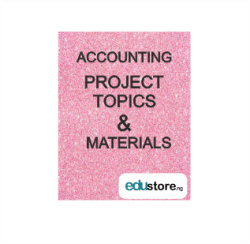Abstract
This study tries to look at the accessibility of credit facility from financial institutions by small and Medium Scale Enterprises: Evidence from Nigeria. Small and Medium Scale Enterprises have been faced with poor funding when developing nations like ours are considered. This however distorts the outstanding function of SMEs as the engine and pivot for the economic growth and national development. No wonder Nigeria has continued to experience high level of emergence of new enterprises that would only exist for two to three years and fizzle out. This study has a broad objective of determining the degree of accessibility of credit facility by SMEs from the financial institution in Nigeria with such variables like government policies, collaterals, tax incentives etc. The study adopted the analytical survey method to gather information on the variables. The population was made up of all the financial controllers in the 360 manufacturing enterprises in the three states under study. We in turn used judgmental sampling technique to select the financial controllers in these manufacturing enterprises. Data were collected by means of questionnaires with response option graduated into a five- likert scale designed to capture information on the variables that affect SMEs. The linear regression analysis was used to test hypotheses one, three and four. One sampled t-test was used to test hypothesis two while a multiple regression analysis was used to test the multiple effects of three independent variables on credit accessibility. The result obtained using the test statistics shows a positive relationship between government policies, access to credit as the greatest problems facing SMEs, tax incentives, availability of collaterals as regards the accessibility of credit facility by SMEs. The research questions proved that international financial assistance abounds for SMEs. The study also showed that the level of the operation of SMEs has not improved when compared with other developed nations. SMEs in Nigeria are faced with numerous challenges and such has affected their performances. We therefore recommend that attention and support be given to the sub-sector so as to enhance their performance as the engine of growth and catalyst for socio-economic transformation in Nigeria. The study has provided opportunities for further research into other factors that could affect SMEs credit accessibility, in order to ascertain if such factors actually affect them in equal measures or not.
CHAPTER ONE
INTRODUCTION
1.1 Background of the Study
A business whether small or big, simple or complex, private or public is created to either provide competitive prices make profit, provide social services or add value (Ayozie ,1999). Business in Nigeria has been classified as small, medium and large. However, (SMEs) Small and Medium Enterprises does not have a one way definition rather, its definition is best understood from its characteristic features; level of project costs, turnover, number of employees, ownership composition and capital outlay (Akinsurile,2006).
The Federal and State Ministries of Industry and Commerce have adopted the criteria of value of fixed capital to determine what Small and medium scale enterprises (SMEs) definition would be. The National Council of Industries defined SMEs as those businesses whose capital base excluding land is not more than N2m only and employee ranges from 10 to 300 persons (Akimade,1991). However, this value rose from N60, 000 in 1972, N159, 000 in 1975, N250, 000 in 1986 before rising to N2m in 1991. On the other hand, small and Medium Scale Industries development Act 2003 specified that SME employee rages from 10-199, Assets excluding land and building fall between (5 and 499) million Naira only.
DOWNLOAD COMPLETE WORK
DISCLAIMER:
- For Reference Only: Materials are for research, citation, and idea generation purposes and not for submission as your original final year project work.
- Avoid Plagiarism: Do not copy or submit this content as your own project. Doing so may result in academic consequences.
- Use as a Framework: This complete project research material should guide the development of your own final year project work.
- Academic Access: This platform is designed to reduce the stress of visiting school libraries by providing easy access to research materials.
- Institutional Support: Tertiary institutions encourage the review of previous academic works such as journals and theses.
- Open Education: The site is maintained through paid subscriptions to continue offering open access educational resources.






